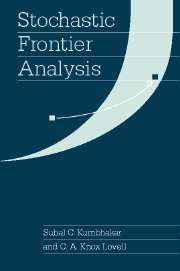Book contents
- Frontmatter
- Contents
- Preface
- 1 Introduction
- 2 Analytical Foundations
- 3 The Estimation of Technical Efficiency
- 4 The Estimation and Decomposition of Cost Efficiency
- 5 The Estimation and Decomposition of Profit Efficiency
- 6 The Shadow Price Approach to the Estimation and Decomposition of Economic Efficiency
- 7 Incorporating Exogenous Influences on Efficiency
- 8 The Estimation of Efficiency Change and Productivity Change
- References
- Author Index
- Subject Index
3 - The Estimation of Technical Efficiency
Published online by Cambridge University Press: 05 June 2012
- Frontmatter
- Contents
- Preface
- 1 Introduction
- 2 Analytical Foundations
- 3 The Estimation of Technical Efficiency
- 4 The Estimation and Decomposition of Cost Efficiency
- 5 The Estimation and Decomposition of Profit Efficiency
- 6 The Shadow Price Approach to the Estimation and Decomposition of Economic Efficiency
- 7 Incorporating Exogenous Influences on Efficiency
- 8 The Estimation of Efficiency Change and Productivity Change
- References
- Author Index
- Subject Index
Summary
INTRODUCTION
In this chapter we begin our econometric analysis of productive efficiency. The chapter is long, but our focus is fairly narrow. Throughout the chapter we explore various econometric models designed to provide estimates of technical efficiency, and so we are implementing the theoretical material developed in Section 2.3. Throughout most of the chapter we confine our exploration to the estimation of technical efficiency under the assumption that producers produce only a single output, either because they actually do produce only a single output or because it is possible to aggregate their multiple outputs into a single-output index. Thus we are implementing the theoretical material developed in Section 2.3.2. Production frontiers provide the standards against which producer performance is evaluated, and performance is evaluated by means of an output-oriented measure of technical efficiency. Only in Section 3.2.3 do we relax the singleoutput assumption. There we implement the theoretical material developed in Section 2.3.3 by exploring the estimation of stochastic distance functions, which do accommodate multiple outputs.
Throughout the chapter we limit our discussion to single-equation models. In these models the parameters describing the structure of a production frontier are estimated, and estimates of the outputoriented technical efficiency of each producer are obtained as a byproduct of the exercise. The data underlying the exercise consist of observations on the quantities of inputs employed and the output produced by each producer. No price information is used, and no behavioral objective is imposed on producers.
- Type
- Chapter
- Information
- Stochastic Frontier Analysis , pp. 63 - 130Publisher: Cambridge University PressPrint publication year: 2000
- 2
- Cited by



